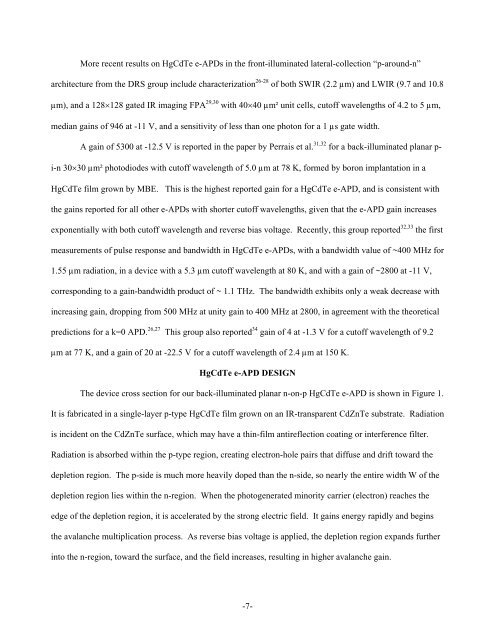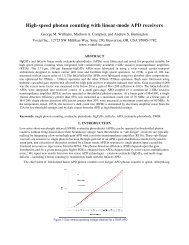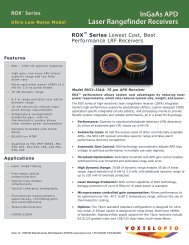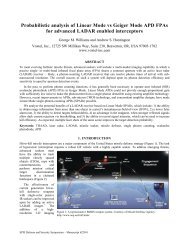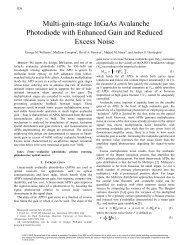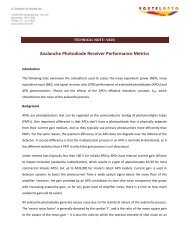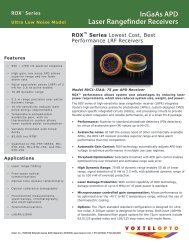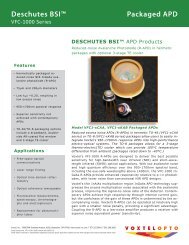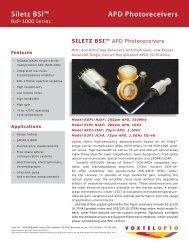Characterization of HgCdTe MWIR Back-Illuminated II-VI-07 ... - Voxtel
Characterization of HgCdTe MWIR Back-Illuminated II-VI-07 ... - Voxtel
Characterization of HgCdTe MWIR Back-Illuminated II-VI-07 ... - Voxtel
- No tags were found...
You also want an ePaper? Increase the reach of your titles
YUMPU automatically turns print PDFs into web optimized ePapers that Google loves.
More recent results on <strong>HgCdTe</strong> e-APDs in the front-illuminated lateral-collection “p-around-n”<br />
architecture from the DRS group include characterization 26-28 <strong>of</strong> both SWIR (2.2 µm) and LWIR (9.7 and 10.8<br />
µm), and a 128×128 gated IR imaging FPA 29,30 with 40×40 µm² unit cells, cut<strong>of</strong>f wavelengths <strong>of</strong> 4.2 to 5 µm,<br />
median gains <strong>of</strong> 946 at -11 V, and a sensitivity <strong>of</strong> less than one photon for a 1 µs gate width.<br />
A gain <strong>of</strong> 5300 at -12.5 V is reported in the paper by Perrais et al. 31,32 for a back-illuminated planar p-<br />
i-n 30×30 µm² photodiodes with cut<strong>of</strong>f wavelength <strong>of</strong> 5.0 µm at 78 K, formed by boron implantation in a<br />
<strong>HgCdTe</strong> film grown by MBE. This is the highest reported gain for a <strong>HgCdTe</strong> e-APD, and is consistent with<br />
the gains reported for all other e-APDs with shorter cut<strong>of</strong>f wavelengths, given that the e-APD gain increases<br />
exponentially with both cut<strong>of</strong>f wavelength and reverse bias voltage. Recently, this group reported 32,33 the first<br />
measurements <strong>of</strong> pulse response and bandwidth in <strong>HgCdTe</strong> e-APDs, with a bandwidth value <strong>of</strong> ~400 MHz for<br />
1.55 µm radiation, in a device with a 5.3 µm cut<strong>of</strong>f wavelength at 80 K, and with a gain <strong>of</strong> ~2800 at -11 V,<br />
corresponding to a gain-bandwidth product <strong>of</strong> ~ 1.1 THz. The bandwidth exhibits only a weak decrease with<br />
increasing gain, dropping from 500 MHz at unity gain to 400 MHz at 2800, in agreement with the theoretical<br />
predictions for a k=0 APD. 26,27 This group also reported 34 gain <strong>of</strong> 4 at -1.3 V for a cut<strong>of</strong>f wavelength <strong>of</strong> 9.2<br />
µm at 77 K, and a gain <strong>of</strong> 20 at -22.5 V for a cut<strong>of</strong>f wavelength <strong>of</strong> 2.4 µm at 150 K.<br />
<strong>HgCdTe</strong> e-APD DESIGN<br />
The device cross section for our back-illuminated planar n-on-p <strong>HgCdTe</strong> e-APD is shown in Figure 1.<br />
It is fabricated in a single-layer p-type <strong>HgCdTe</strong> film grown on an IR-transparent CdZnTe substrate. Radiation<br />
is incident on the CdZnTe surface, which may have a thin-film antireflection coating or interference filter.<br />
Radiation is absorbed within the p-type region, creating electron-hole pairs that diffuse and drift toward the<br />
depletion region. The p-side is much more heavily doped than the n-side, so nearly the entire width W <strong>of</strong> the<br />
depletion region lies within the n-region. When the photogenerated minority carrier (electron) reaches the<br />
edge <strong>of</strong> the depletion region, it is accelerated by the strong electric field. It gains energy rapidly and begins<br />
the avalanche multiplication process. As reverse bias voltage is applied, the depletion region expands further<br />
into the n-region, toward the surface, and the field increases, resulting in higher avalanche gain.<br />
-7-


